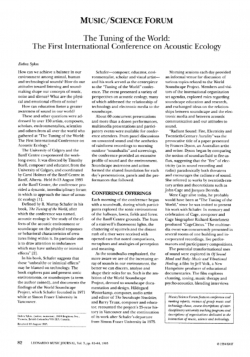The Tuning of the World: The First International Conference on Acoustic Ecology

Type
Journal
Authors
Sykes ( Debra Sykes )
Category
Article
[ Browse Items ]
Publication Year
1993
Publisher
Leonardo, United States
URL
[ private ]
Volume
3
Pages
82-84
Abstract
How can we achieve a balance in our environment among animal, human and technological sounds? How do our attitudes toward listening and soundmaking shape our concepts of music, noise and silence? What are the physical and emotional effects of noise? How can education foster a greater awareness of sound in our world? These and other questions were addressed by over 150 artists, composers, scholars, environmentalists, scientists and others from all over the world who gathered at ''The Tuning of the World: The First International Conference on Acoustic Ecology." The University of Calgary and the Banff Centre co-sponsored the weeklong event. It was directed by Timothy Buell, composer and educator, from the University of Calgary, and coordinated by Carol Holmes of the Banff Centre in Banff, Alberta. Held 8-13 August 1993 at the Banff Centre, the conference provided a dynamic, interdisciplinary forum in which to approach the issue of acoustic ecology [1]. Defined by R. Murray Schafer in his book, The Tuning ofthe World, after which the conference was named, acoustic ecology is "the study of the effects of the acoustic environment or soundscape on the physical responses or behavioral characteristics of creatures living within it. Its particular aim is to draw attention to imbalances which may have unhealthy or inimical effects" [2]. In his book, Schafer suggests that these "unhealthy or inimical effects" may be blamed on technology. The book explores past and present sonic environments, or soundscapes (a term the author coined), and documents the findings of the World Soundscape Project, which Schafer founded in 1971 while at Simon Fraser University in Vancouver. Debra Sykes, (writer. musician), 1959 Brighton Ave., Victoria, British Columbia V8S 2E3, Canada. Received 18 August 1993. Schafer-composer, educator, environmentalist , scholar and visual artistand his work served as the centerpiece to the "Tuning of the World" conference . The event presented a variety of perspectives on acoustic ecology, many of which addressed the relationship of technology and electronic media to the soundscape. About 60 concurrent presentations and more than a dozen performances, multimedia presentations and participatory events were available for conference attendees. From panel discussions on unwanted sound and the aesthetics of rainforest recordings to morning outdoor "soundwalks" and screenings, the conference provided an extensive profile of sound and the environment. Soundscape awareness and action formed the shared foundation for each day's presentations, panels and the performances that followed. CONFERENCE OFFERINGS Each morning of the conference began with a soundwalk, during which participants explored the sonic environment of the hallways, lawns, fields and forest of the Banff Centre grounds. The hum of a stairwell's fluorescent lights, the chattering of squirrels and the distant rush of a river were received with opened ears that noted comparisons, metaphors and analogies of perception and meaning. As the soundwalks emphasized, the more aware we are of the increasing array of sounds in our environment, the better we can discern, analyze and shape their roles for us. Such is the ambition of the World Soundscape Project, devoted to soundscape documentation and design. Hildegard Westerkamp, composer, audio artist and editor of The Soundscape Newsletter, and Barry Truax, composer and educator , recounted the project's 25-year history in Vancouver and the continuation of its work after Schafer's departure from Simon Fraser University in 1975. 82 LEONARDO MUSIC JOURNAL, Vol. 3, pp. 82-84, 1993 Morning sessions each day provided an informal venue for discussion of various topics related to the World Soundscape Project. Members and visitors of the international organization set agendas, explored roles regarding soundscape education and research, and exchanged ideas on the relationships between soundscape and the electronic media and between acoustic communication and our attitudes to sound. "Radiant Sound: Fire, Electricity and Twentieth-Century Aurality" was the provocative title of a paper presented by Frances Dyson, an Australian artist and writer. Dyson began by comparing the notion of sound-as-fluid to fire-asflux , suggesting that the "fire" of electricity (as in sound recording and radio) paradoxically both threatens and encourages the radiance of sound. She referred to works by twentieth-century artists and theoreticians...
Description
https://muse.jhu.edu/article/617731/summary
Number of Copies
1
| Library | Accession No | Call No | Copy No | Edition | Location | Availability |
|---|---|---|---|---|---|---|
| Main | 149 | 1 | Yes |


